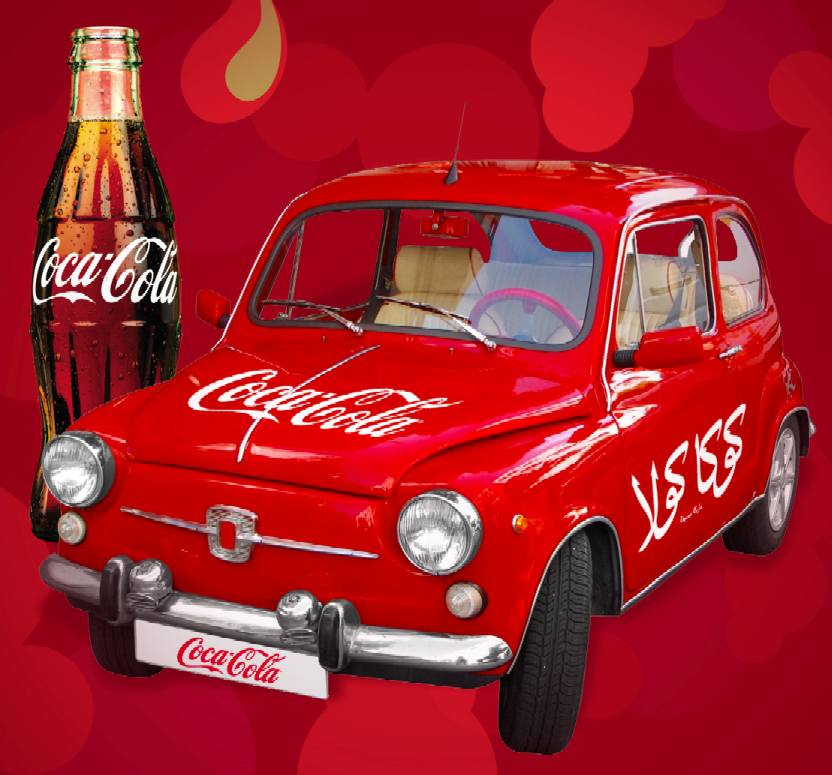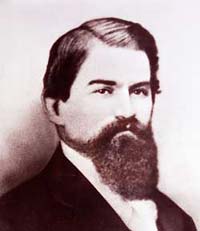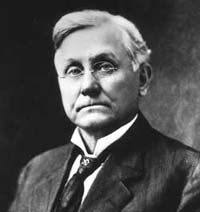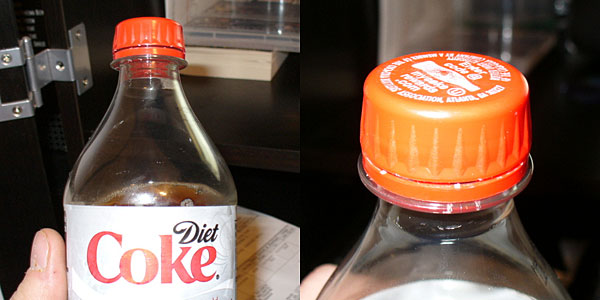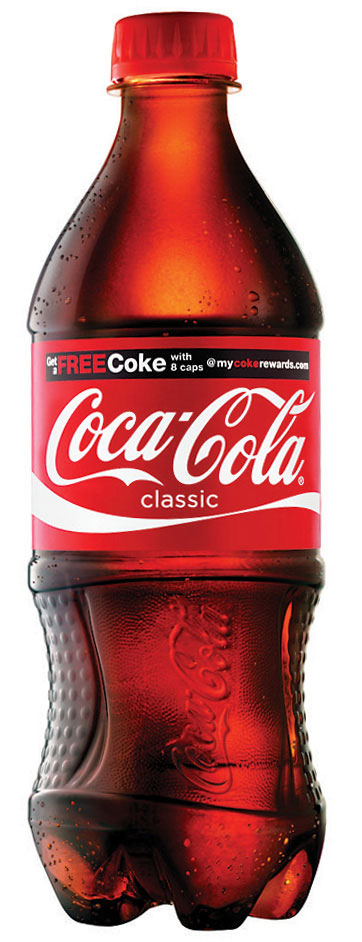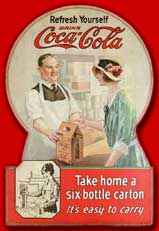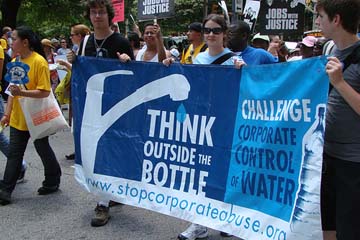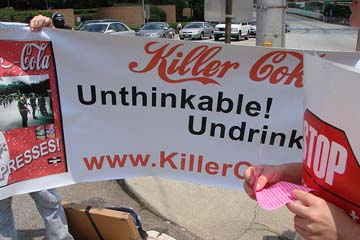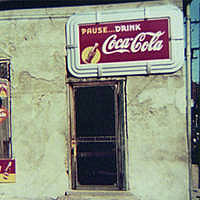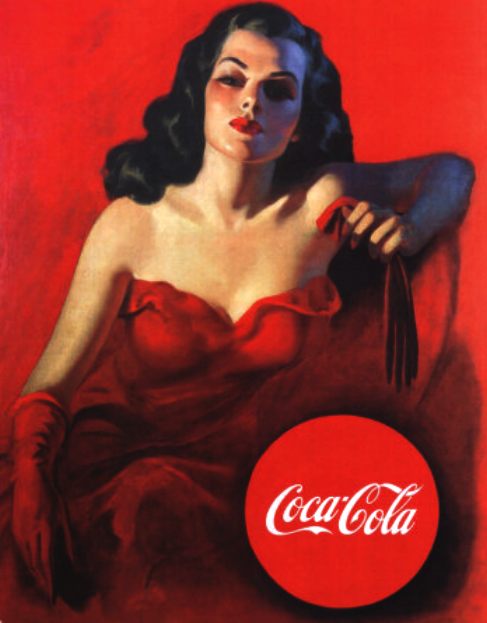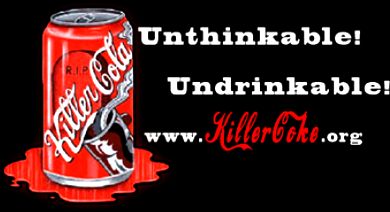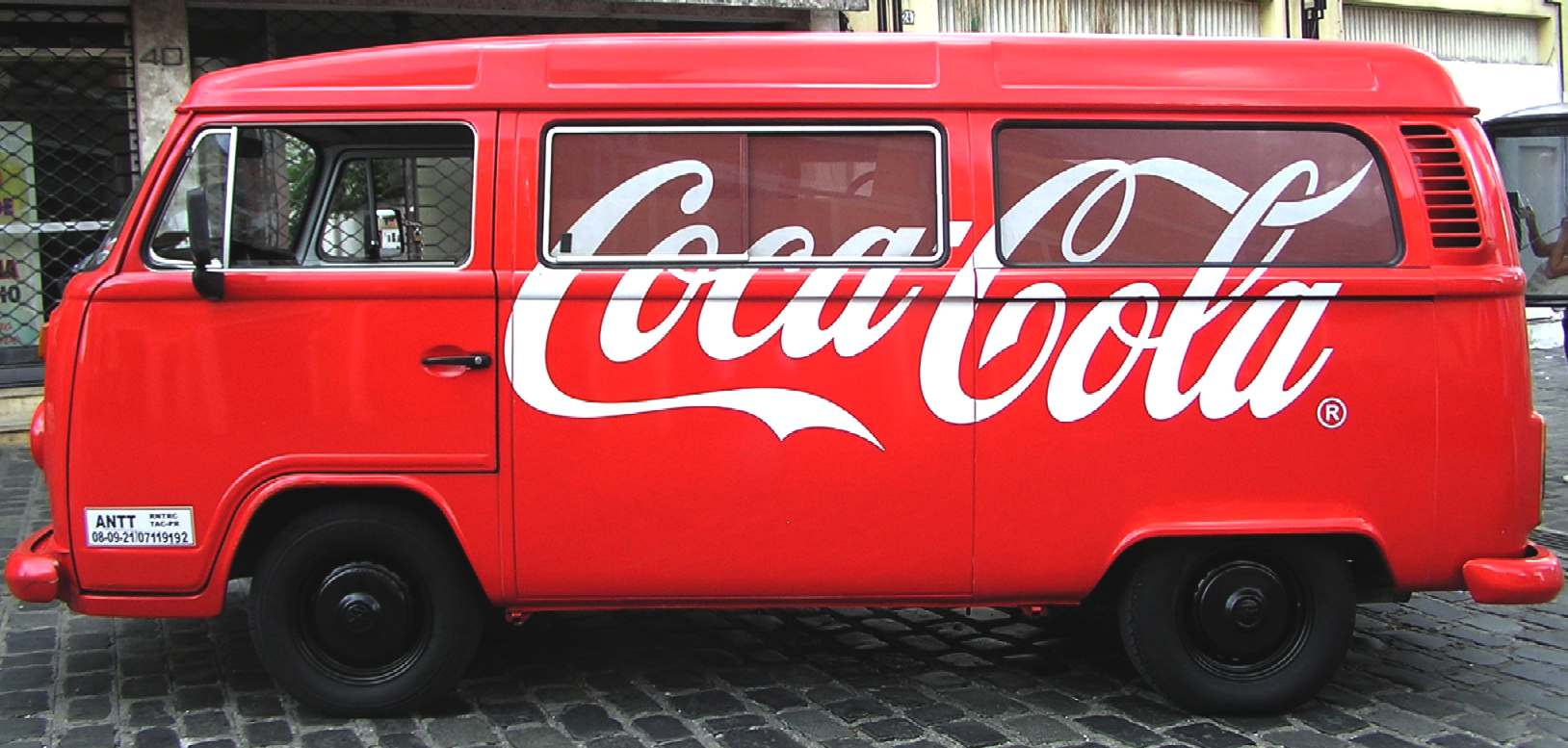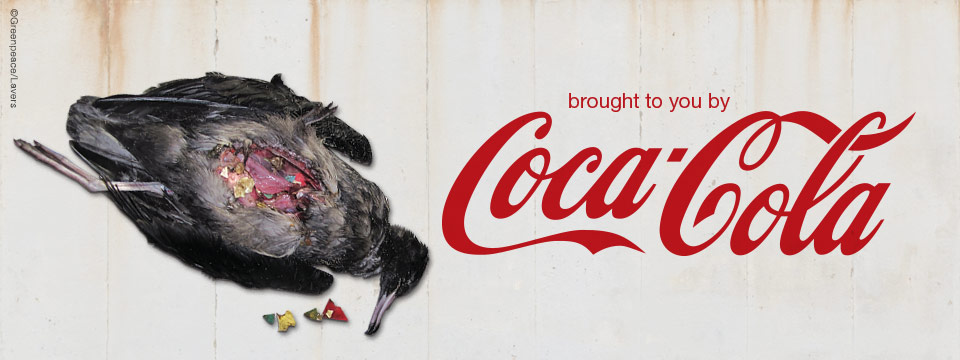|
COCA COLA - MARKETING HISTORY
|
|||
|
In May, 1886, Coca Cola was invented by Doctor John Pemberton a pharmacist from Atlanta, Georgia. John Pemberton concocted the Coca Cola formula in a three legged brass kettle in his backyard. The name was a suggestion given by John Pemberton's book keeper Frank Robinson.
It was a prohibition law, enacted in Atlanta in 1886, that persuaded physician and chemist Dr. John Stith Pemberton to rename and rewrite the formula for his popular nerve tonic, stimulant and headache remedy, "Pemberton's French Wine Coca," sold at that time by most, if not all, of the city's druggists.
So when the new Coca-Cola debuted later that year - still possessing "the valuable tonic and nerve stimulant properties of the coca plant and cola nuts," yet sweetened with sugar instead of wine - Pemberton advertised it not only as a "delicious, exhilarating, refreshing and invigorating" soda-fountain beverage but also as the ideal "temperance drink." It is said coke was discovered when DeLuise, a 19th century American soda jerk accidentally hit the soda water spigot, adding carbonated water to the syrup in the glass. The result was a "happy accident": the invention of Coca-Cola.
Though Pemberton died just two years later - five months, in fact, after his March 24, 1888, filing for incorporation of the first Coca-Cola Co. - the trademark he and his partners created more than one hundred years ago can claim wider recognition today than that of any other brand in the world.
John Pemberton
And the Coca-Cola beverage, whose unit sales totaled a mere 3,200 servings in 1886 ("nine drinks per day" based on the twenty-five gallons of syrup sold to drugstores by Pemberton Chemical Co.), is today called the world's most popular soft drink - accounting for billions of servings at restaurants in 195 countries.
Such is the commercial legacy of a onetime Confederate lieutenant colonel who earned his medical degree at the age of nineteen, who served on the first Georgia pharmacy licensing board, who set up a top-rated laboratory for chemical analysis and manufacturing, and who, in his dozen-and-a-half years in Atlanta, established eighteen business ventures - including one, the Coca-Cola Co., which now can boast 1995 sales in excess of $15 billion.
Notwithstanding Pemberton's numerous professional and entrepreneurial accomplishments, however, Coca-Cola historians characterize him as "a local pharmacist" who concocted the world's most craved soft-drink syrup in a three-legged brass pot in his backyard.
"Coca-Cola was not the creation of an inept, small-time corner druggist," said archivist Monroe Martin King, who has spent twenty-one years researching the life of John Pemberton - from his childhood in Rome, Ga., to his college days in Macon to his enterprising years in Atlanta. "He's occasionally portrayed as a wandering medicine man," King added. "But Dr. Pemberton worked in a fully outfitted laboratory and claimed to manufacture every chemical and pharmaceutical preparation used in the arts and sciences."
According to King, Pemberton's analytical laboratory became the first state-run facility to conduct tests of soil and crop chemicals. It continues to be operated by the Georgia Department of Agriculture. King further noted that Pemberton, who practiced medicine and surgery as a young man and later became a trustee of the former Emory University School of Medicine, earned a solid reputation for his skill in chemistry and his work in medical reform.
But King feels the Coca-Cola Co. of today drew an accurate conclusion when it stated: "Dr. Pemberton never fully realized the potential of the beverage he created." Indeed, while Pemberton gets credit for the formula behind the Coca-Cola taste, he has had capable successors in Asa Candler, Robert Woodruff and Roberto Goizueta - men who built the product and the company into an icon of pleasure and profit.
According to King, Pemberton actually remained more interested in expanding the market for French Wine Coca, a product based on the formula for another extremely popular coca-based beverage, Vin Mariani, which had been developed in Paris in 1863. So when Atlanta's prohibition act was repealed in 1887, only a year after its passage, Pemberton resumed the manufacture and sale of his original patent medicine, leaving his son Charles to oversee the production of Coca-Cola.
Although Pemberton may have envisioned a future for his soft-drink creation--enticing six Atlanta businessmen to invest in the start-up Coca-Cola enterprise--for reasons that remain a mystery he soon began selling his interest in the formula.
"Dr. Pemberton . . . must have believed that it had little value and no potential assurance of substantial success," said Charles Candler in a 1953 biographical sketch about his father, titled "Asa Griggs Candler, Coca-Cola and Emory College."
Being a bookkeeper, Frank Robinson also had excellent penmanship. It was he who first scripted "Coca Cola" into the flowing letters which has become the famous logo of today. The soft drink was first sold to the public at the soda fountain in Jacob's Pharmacy in Atlanta on May 8, 1886.
About nine servings of the soft drink were sold each day. Sales for that first year added up to a total of about $50. The funny thing was that it cost John Pemberton over $70 in expenses, so the first year of sales were a loss. Until 1905, the soft drink, marketed as a tonic, contained extracts of cocaine as well as the caffeine-rich kola nut.
By the late 1890s, Coca-Cola was one of America's most popular fountain drinks. With another Atlanta pharmacist, Asa Griggs Candler, at the helm, the Coca-Cola Company increased syrup sales by over 4000% between 1890 and 1900.
Advertising, was an important factor in Pemberton and Candler's success and by the turn of the century, the drink was sold across the United States and Canada. Around the same time, the company began selling syrup to independent bottling companies licensed to sell the drink. Even today, the US soft drink industry is organized on this principle.
Asa Candler, who, according to King, had worked for Pemberton as early as 1872, wound up, after a series of transactions, controlling the company within a short time of Pemberton's death. By 1891 he owned all of the Coca-Cola business. Charles Candler relates that one of his father's first missions was to change the original Pemberton formula in order "to improve the taste of the product, to ensure its uniformity and its stability."
According to Asa Candler's son, Candler hired Pemberton's former partner, Frank Robinson. The two of them, "by adding essential ingredients and taking others out . . . perfected the formula," Charles Candler said. In fact, it was Robinson who created the Coca-Cola name and script logo, convincing the company to tie the classic slogan "delicious and refreshing" into all future advertising.
After the turn of the century, when federal and state authorities began writing regulations to ban the sale of coca products because of their supposed contamination with the drug cocaine, Coca-Cola lawyers argued strenuously that their syrup contained only a minuscule flavor extract of the coca leaf.
Coca-Cola attorneys also were called to battle against competitors who called the product name a misrepresentation if, as argued, its principal ingredients were neither the coca leaf nor the kola nut--a source of caffeine that made the early beverage useful in healing headaches.
Despite such obstacles, Candler's prowess as a merchandiser had driven the widely promoted Coca-Cola beverage into "every state and territory in the United States" by 1895. Considered a pioneer in coupon promotions, Candler offered two gallons of Coca-Cola syrup "to any retailer or soda fountain man" who would dispense 128 free servings (a gallon's worth) of the beverage to customers who showed up with one of his cards.
Not only were syrup manufacturing facilities opening in such cities as Dallas, Chicago and Los Angeles, but a network of bottlers was being created nationwide as well. Under Woodruff's tenure, from 1923 until 1981, Coca-Cola rose from national to international dominance--a move accompanied by the early, explosive growth of the bottled beverage.
By 1928 bottled sales had eclipsed fountain sales, thanks to the pioneering introduction of a carton now popularly called the six-pack. The following year the company introduced metal open-top coolers. Then in 1933 at the Chicago World Fair automatic fountain dispensers made their debut. Having expanded the brand into fourty-four countries by the outbreak of World War II, Woodruff, within fifteen years of the war's end, had managed to double that number. "Now the saying is you have to be global," said Goizueta, Coca-Cola's current chairman and chief executive. "We were global when global wasn't cool."
Two decades later, when Coca-Cola's board elected Goizueta to the post of chairman and chief executive, the company was embarked on a financial mission--to become one of the best-performing corporations in America. Average annual fountain-sales growth under Goizueta has continued to surge. And despite consumer uproar over the company's attempted Coca-Cola reformulation in 1985, the introduction of Diet Coke in 1982 was hailed as the most successful product launch of the past decade.
Yet none of the company's strides in marketing, international expansion, product innovation or profit growth could have happened had it not been for Coca-Cola's inventor, John Pemberton. Atlanta druggists--Asa Candler among them--closed their stores on the day of Pemberton's funeral "and attended the services in mass as a tribute of respect," according to newspaper records from that era. "On that day," declared archivist Monroe King, "not one drop of Coca-Cola was dispensed in the entire city."
Asa Griggs Candler
Until the 1960s, both small town and big city dwellers enjoyed carbonated beverages at the local soda fountain or ice cream saloon. Often housed in the drug store, the soda fountain counter served as a meeting place for people of all ages. Often combined with lunch counters, the soda fountain declined in popularity as commercial ice cream, bottled soft drinks, and fast food restaurants came to the fore.
On April 23, 1985, the trade secret "New Coke" formula was released. Today, products of the Coca Cola Company are consumed at the rate of more than one billion drinks per day.
A trade secret is any information that allows you to make money because it is not generally known. A trade secret could be a formula, computer program, process, method, device, technique, pricing information, customer lists or other non-public information. If the economic value of a piece of information relies on it being kept private, it could be a trade secret.
One of the most famous examples of a trade secret is the formula for Coca-Cola. The formula, also referred to by the code name "Merchandise 7X," is known to only a few people within the company and kept in the vault of a bank in Atlanta, Georgia. The individuals who know the secret formula have signed non-disclosure agreements, and it is rumored that they are not allowed to travel together. In the past, you could not buy Coca-Cola in India because Indian law required that trade-secret information be disclosed. In 1991, India changed its laws regarding trademarks, and Coca-Cola can now be sold in that country.
Trade secrets are very different from patents, copyrights and trademarks. While patents and copyrights require you to disclose your information in the application process (information that eventually becomes public), trade secrets require you to actively keep the information secret. Trade-secret protection can potentially last longer than that of patents (20 years) and copyrights (100 years). Some of the ways to protect a trade secret are as follows:
Trade secrets remain valid only as long as no one else has discovered the information independently, the information has not been made public (by employees or published literature) nor discovered by working backward from the original product/process or publicly observing the product/process. If the trade secret is revealed in violation of a non-disclosure agreement, you can sue for damages. However, once the secret is revealed, it is hard to get the trade-secret status resumed. Trade secrets are protected under many state laws, Federal statutes and some international laws.
Further Development of the Drink
The Coca-Cola company started out as an insignificant one man business and over the last one hundred and ten years it has grown into one of the largest companies in the world. The first operator of the company was Dr. John Pemberton and the current operator is Roberto Goizueta. Without societies help, Coca-Cola could not have become over a 50 billion dollar business. Coca-Cola was invented by Dr. John Pemberton, an Atlanta pharmacist. He concocted the formula in a three legged brass kettle in his backyard on May 8, 1886. He mixed a combination of lime, cinnamon, coca leaves, and the seeds of a Brazilian shrub to make the fabulous beverage (Things go better with Coke 14). Coca-Cola debuted in Atlanta's largest pharmacy, Jacob's Pharmacy, as a five cent non- carbonated beverage.
Later on, the carbonated water was added to the syrup to make the beverage that we know today as Coca-Cola. Coca-Cola was originally used as a nerve and brain tonic and a medical elixir. Coca-Cola was named by Frank Robinson, one of Pemberton's close friends, he also penned the famous Coca-Cola logo in unique script. Dr. John Pemberton sold a portion of the Coca-Cola company to Asa Candler, after Pemberton's death the remainder was sold to Candler. Pemberton was forced to sell because he was in a state of poor health and was in debt. He had paid $76.96 for advertising, but he only made $50.00 in profits. Candler acquired the whole company for $2,300 (Coca-Cola multiple pages). Candler achieved a lot during his time as owner of the company. On January 31, 1893, the famous Coca-Cola formula was patented. He also opened the first syrup manufacturing plant in 1884. His great achievement was large scale bottling of Coca-Cola in 1899. In 1915, The Root Glass Company made the contour bottle for the Coca-Cola company.
Candler aggressively advertised Coca-Cola in newspapers and on billboards. In the newspapers, he would give away coupons for a free Coke at any fountain. Coca-Cola was sold after the Prohibition Era to Ernest Woodruff for 25 million dollars. He gave Coca-Cola to his son, Robert Woodruff, who would be president for six decades (Facts, Figures, and Features Multiple pages). Robert Woodruff was an influential man in Atlanta because of his contributions to area colleges, universities, businesses and organizations. When he made a contribution, he would never leave his name, this is how he became to be known as "Mr. Anonymous."
Woodruff introduced the six bottle carton in 1923. He also made Coca-Cola available through vending machine in 1929, that same year, the Coca- Cola bell glass was made available. He started advertising on the radio in the 1930s and on the television in 1950. Currently Coca-Cola is advertised on over five hundred TV channels around the world. In 1931, he introduced the Coke Santa as a Christmas promotion and it caught on. Candler also introduced the twelve ounce Coke can in 1960. The Coca-Cola contour bottle was patented in 1977. The two liter bottle was introduced in 1978, the same year the company also introduced plastic bottles (Coca-Cola multiple pages).
Woodruff did have one dubious distinction, he raised the syrup prices for distributors. But he improved efficiency at every step of the manufacturing process. Woodruff also increased productivity by improving the sales department, emphasizing quality control, and beginning large-scale advertising and promotional campaigns. Woodruff made Coke available in every state of the Union through the soda fountain. For all of these achievements he earned the name, "The Boss" (Facts, Figures, and Features Multiple pages).
In 1985, the Coca-Cola Company made what has been known as one of the biggest marketing blunder. The Coca-Cola company stumbled onto the new formula in efforts to produce diet Coke. They put forth 4 million dollars of research to come up with the new formula.
The decision to change their formula and pull the old Coke off the market came about because taste tests showed a distinct preference for the new formula. The new formula was a sweeter variation with less tang, it was also slightly smoother (Demott 54). Robert Woodruff's death was a large contributor to the change because he stated that he would never change Coca-Cola's formula. Another factor that influenced the change was that Coke's market share fell 2.5 percent in four years. Each percentage point lost or gain meant 200 million dollars. A financial analyst said, "Coke's market share fell from 24.3 percent in 1980 to 21.8 percent in 1984" (Things go better with Coke 14).
This was the first flavor change since the existence of the Coca- Cola company. The change was announced April 23, 1985 at the Vivian Beaumont Theater at the Lincoln Center. Some two hundred TV and newspaper reporters attended this very glitzy announcement. It included a question and answer session, a history of Coca-Cola, and many other elements (Oliver 131).
The debut was accompanied by an advertising campaign that revived the Coca-Cola theme song of the early 1970s, "I'd Like to Buy the World a Coke" (Say it ain't so, Coke 24). The Jingle read like this: I'd like to teach the world to sing In perfect harmony. I'd like to buy the world a Coke And keep it company. The change to the world's best selling soft drink was heard by 81 percent of the United States population within twenty-four hours of the announcement. Within a week of the change, one thousand calls a day were flooding the company's eight hundred number (1-800-GET-COKE). Most of the callers were shocked and/or outraged, many said that they were considering switching to Pepsi. Within six weeks, the eight hundred number was being jammed by six thousand calls a day. The company also fielded over forty thousand letters, which were all answered and each person got a coupon for the new Coke. A retired Air Force officer, explained in a letter to the Coca-Cola company that he wanted to be cremated and interred in a Coke can, but now that this change had come about he was reconsidering (Pendergrast Multiple pages).
Sharlotte Donneally, a thirty-six year old anthropologist said, "I hate the new stuff" (Demott 60). Wendy Koskela, a thirty-five year old vice president of an insurance company said, "It's too sweet. It tastes like Pepsi." She also stated, "Real Coke had punch. This taste almost like it's flat" (Demott 60). Many American consumers of Coca-Cola asked if they would have the final say. When Pepsi heard that the Coca-Cola company was changing its secret formula they said that it was a decision that Pepsi tastes better. Roger Enrico, the president and CEO of Pepsi-Cola wrote a letter to every major newspaper in the U.S. to declare the victory, the letter read like this (Oliver 128): It gives me great pleasure to offer each of you my heartiest congratulations. After eighty-seven years of going at it eyeball to eyeball, the other guy just blinked. Coca-Cola is withdrawing their product from the marketplace, and is reformulating brand Coke to be more like Pepsi...There is no question the long-term market success of Pepsi has forced this move...Maybe they finally realized what most of us have known for years, Pepsi tastes better than Coke. Well, people in trouble tend to do desperate things...and we'll have to keep our eye on them. But for now, I say, victory is sweet, and we have earned a celebration. We're going to declare a holiday on Friday. Enjoy! Best Regards, Roger Enrico President, CEO Pepsi-Cola USA Coca-Cola officials said, "The new formula will boost Coke's share by 1 percent. That is worth 200 million dollars a year."
Coca-Cola management had to decide: Do nothing or "buy the world a new Coke" (Things go better with Coke 14). They decided to develop the new formula. Roberto Goizueta, the president of the Coca-Cola Company stated, "The old Coke formula, with its secret flavoring ingredient, called Merchandise 7X, will stay locked in the Trust Company of Georgia bank vault in Atlanta, never to be used again" (Demott et. al 55). This is what many Coke officials said, "This is the most significant soft drink development in the company's history" (Demott et. al 54). The change back to the old Coke was known as the Second Coming. Roberto Goizueta said, "Today, we have two messages to deliver to the American consumer, first, to those of you who are drinking Coca-Cola with its great new taste, our thanks...But there is a second group of consumers to whom we want to speak to today and our message to this group is simple: We have heard you" (Oliver 178). On July 10, 1985, eighty-seven days after the new Coke was introduced, the old Coke was brought back in addition to the new one. This was greatly due to dropping market share and consumer protest. The market share fell from a high of 15 percent to a low of 1.4 percent (Miller 38). Roberto Goizueta and Donald Keough took full blame for this failed product launch. Don Keough, Coca-Cola president, said in response to the comeback, "The truth is we are not dumb and we are not that smart" (New bottle 18). Roberto Goizueta's response when the change about, "We have heard you" (Moore 8). This was said to be a classic marketing retreat.
Coca-Cola executives admitted that they had goofed by taking the old Coke off the market. One old Coke loyalist said, "The company had spoiled the taste of its ninety nine year old soft drink and betrayed a national trust" (Moore 8). Ike Herbert, a Coke marketer said, "You would have thought we had invented a cure for cancer" (Pendergrast 366). The Coca- Cola company's eight hundred number received eighteen thousand calls of gratitude. One caller said they felt like a lost friend had returned home. The comeback of old Coke drove stock prices to the highest level in twelve years. This was said to be the only way to regain the lead on the cola wars (Classic comeback of an old champ 12). In 1979, fifteen hundred employees moved to the new corporate headquarters in Atlanta located on North Avenue. The new corporate headquarters came to be known as "The Tower."
During the time when the research for the new formula was taking place, it was known as "The Bunker" (Oliver 53). The known ingredients in present day Coca-Cola are water. caffeine, phosphoric acid, vanilla, various oils and essences and extracts of the coca leaf and the kola nut. The one in four hundred part of cocaine was removed from Coca-Cola in 1903 (Demott 54). Five years after the infamous Coke fiasco, the Coca-Cola company tried to bring back the reformulated Coke.
The effort to phase in Coke II into the soda market was quite unsuccessful (Miller 38). During the Woodruff era, Mr. Woodruff made a promise to the armed forces of the United States to supply Coca-Cola to every serviceperson. He said that costs and location did not matter, he supplied 5 billion bottles to the service. In the mid-1970's, more than half Coca-Cola sold was outside of the U.S. Coca-Cola products outsell closest competitor by more than two to one. One in every two colas and one in every three soft drinks is a Coca-Cola product (Facts, Figures, and Features 16). The best known trademark in the world is sold in about one hundred and forty countries to 5.8 billion people in eighty different languages. This is why Coca-Cola is the largest soft drink company in the world. Coca-Cola is worth more than 58 billion dollars on the stock market (Coca-Cola, The Coca-Cola Company 232). For more than 65 years, Coca-Cola has been a sponsor of the Olympics.
The 1996 Summer Olympics will be held in Atlanta, Georgia, the home of Coca-Cola. One great earmark that the Coca-Cola company has is helping the people of Atlanta. They accomplish this through scholarships, hotlines, donations and contributions, etc. Another large accomplishment that the Coca-Cola has, is being the first company to make and use recycled plastic bottles. One way to see all of the achievements of the Coca- Cola company is to visit the World of Coke in Atlanta. It houses a collection of memorabilia, samples of the products, exhibits, and many other exciting items (Facts, Figures, and Features Multiple pages). All of what has been said is the basis of what Coca-Cola was built on. Without societies help, Coca-Cola could not have become over a 50 billion dollar business. Keep on consuming the world's favorite soft drink, Coca-Cola.
BOOK DESCRIPTION
Coca-Cola has become such a ubiquitous American symbol such that it's often hard to distinguish where mere substance ends (its formula is a secret as closely held as military stealth technology) and its seductively overwhelming marketing begins. But in the 1980s and '90s, Coke's new corporate management evolved it from a reliable, if sometimes stodgy, icon of American industry into one of the hottest stocks in a notoriously overheated bull market. That explosive corporate evolution is the focus of veteran NY Times beverage industry reporter Constance Hays' cautionary business history.
Eschewing strict chronology in favor of skillfully weaving in appropriate pieces of the company's complex legacy and unique coporate culture to underscore their impact on the contemporary story at hand, Hays carefully dissects a company billed in boom years as a virtual perpetual profit machine of boundless potential. Coke's growth was largely the product of Roberto Goizueta, the methodical, Cuban-born chemist who'd risen through the company's ranks and outflanked fellow veteran executive/personable "super salesman" Don Keough to become its CEO. Goizueta may have been able to rise above the hubris-fueled "New Coke" reformulation fiasco of the mid-80s, but his penchant for ruthless market expansion, corporate rejiggering and tight control of the company's operating details and financial numbers would also sow the seeds for the inevitable collapse that halved Coke's value. That implosion quickly took down successor CEO Doug Forrester--ironically the original financial architect of much of the company's remarkable boom.
While this is largely a business history and not a cultural one, it's filled with a wealth of telling human details: corporate pressures exerted on family-owned Coke bottlers to sell out; an obscure academic/stock analyst whose curiosity helped unravel the company's financial secrets; Machiavellian corporate politics where one era's loser becomes another's cautious victor.
KILLER COLA CAMPAIGN
.......
Coca-Cola Trademarks Australia
The
Coca-Cola Company
History
of Coca Cola and its Evolution
- A long and detailed history of Coca Cola. Dr.
John Pemberton
- Inventor of Coca-Cola History
of Pop
- Timeline of the entire history of soft drinks.
ON THE BOOKSHELF:
.. Thirst for Life
Solar Cola 330ml Earth can - now reserved for the launch of the Cleaner Ocean Project
Please note: For the avoidance of doubt, neither Max Energy Ltd, nor Solar Cola Ltd is in any way connected with any Coca Cola company. Nor is there any association between Coca Cola and any project mentioned on this website, unless specifically stated.
We aim to provide balanced unbiased reporting on sailing events, global warming and renewable energy usage in the modern world. If you have a story you would like us to cover, please use the contact given at the foot of this page. We are not responsible for the content of third party websites.
COKE BOTTLES - It's not Coca Cola's fault alone. This is a massive problem for all producers of soft drinks. What would be nice is that the companies producing drinks to be sold in PET bottles, might think of contributing to projects aimed at cleaning up the inevitable spillage into the oceans, such that those who may, are given the support they need to get things moving.
|
|||
|
This
website is copyright © 1991- 2015 Electrick Publications. All rights
reserved. The bird logo |
